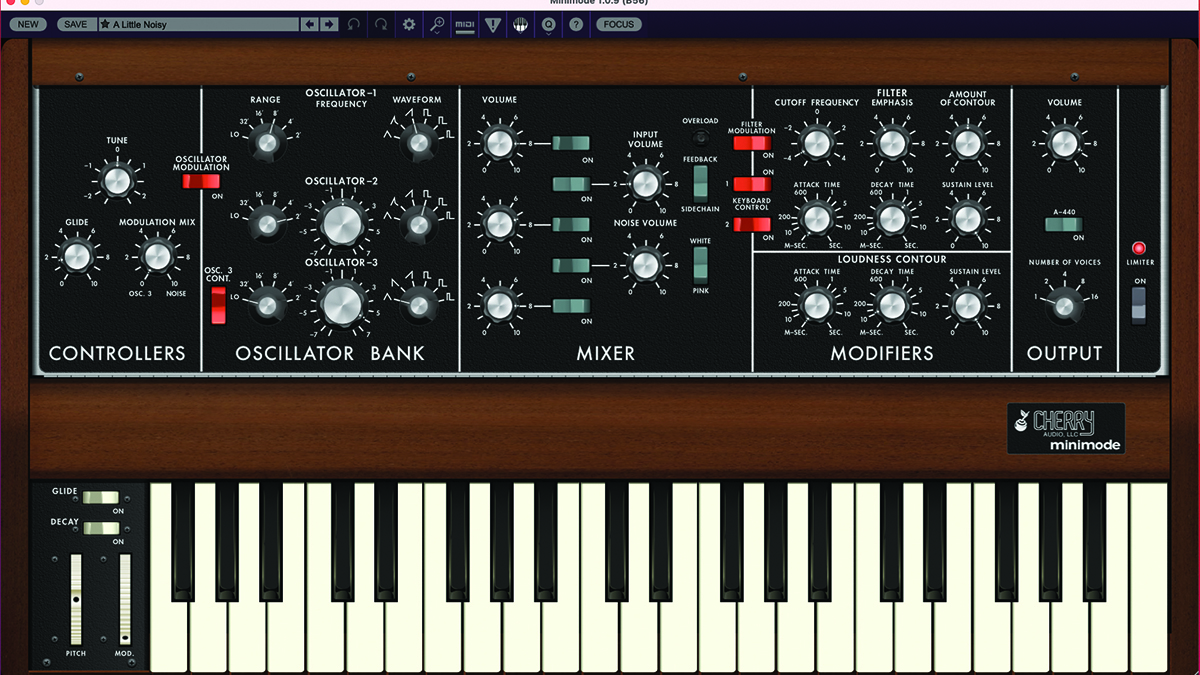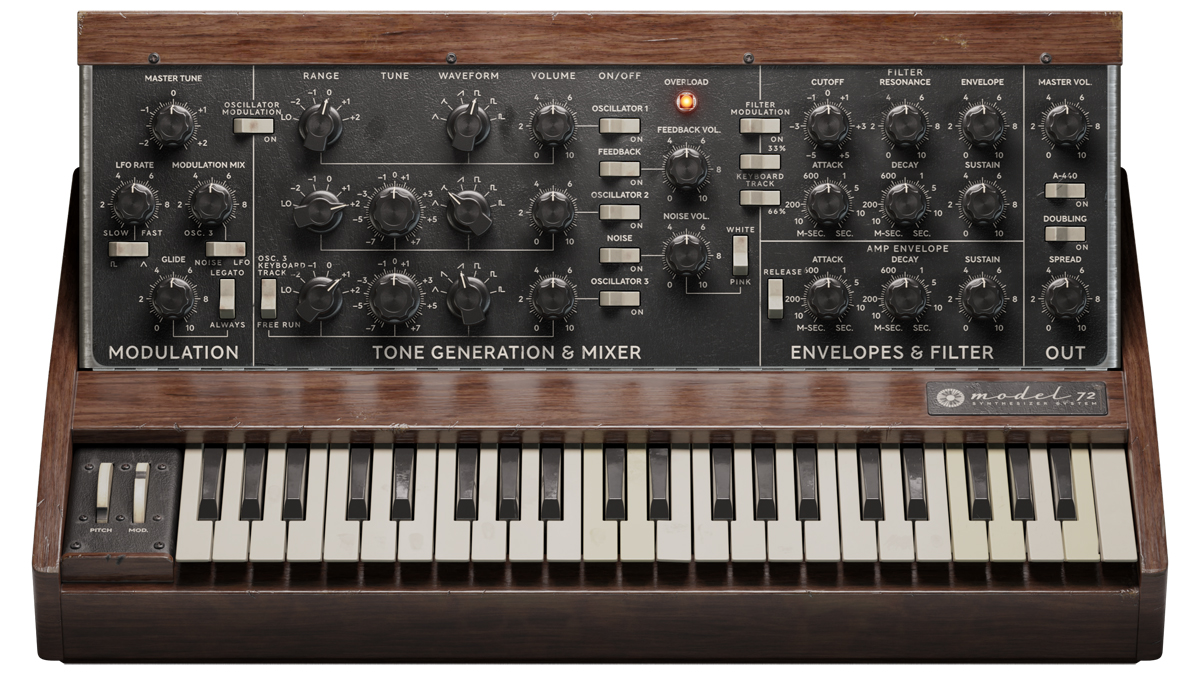MusicRadar Verdict
As classical re-enactments go, this is a no-holds-barred unashamed recreation of a Minimoog, which sounds sensational, even at an amazingly attractive price!
Pros
- +
Stunningly accurate emulation.
- +
Beautiful GUI styling and fully resizable.
- +
Overdrive loop on-board.
- +
It’s stunning in Polyphonic Mode.
Cons
- -
No additional LFO for vibrato.
- -
No on-board effects.
MusicRadar's got your back
Cherry Audio Miniverse: What is it?
If there is one synth that is ubiquitous in all senses, it has to be the Minimoog. As a consequence, it’ll come as no surprise to discover that it is one of the most reimagined synths to appear in software. Any new plugin incarnation is therefore going to require some pretty hefty calling cards to tempt people away from their favoured versions, or indeed entice first-timers into the Minimoog World.
System requirements:
Available in AU, VST, VST3, AAX, and standalone formats
macOS 10.9 or above (including macOS 12), 64-bit required
Windows 7 or above, 64-bit required.
Where to buy: Plugin Boutique or Cherry Audio
So we must begin with the lowest common denominator; Miniverse is priced at an extraordinarily low $59, the Cherry Audio ethos being that everyone deserves a Minimoog, and it is difficult to disagree. But what good is a low price, if the software itself doesn’t sound like the real McCoy? Well, that’s just it! It does!
The Miniverse is available in all of the usual plugin formats; AU, VST and AAX, while also offering a nicely styled standalone version. From the initial loading, you are struck by the resizable window, which boasts the classic and clear signal path, in a retro GUI which is pretty exacting to an original Mini. There is plenty of attention to detail, from the use of the same Moog font to the colour palette. Original Minimoogs provided a basic tuning oscillator, which always emitted a slight delay in volume, which switched on, and while we don’t really need the tuning oscillator on a plugin, it’s there and it exhibits the same delay-like behaviour when activated. Cute!

Cherry Audio Miniverse: Performance and verdict
As a company, Cherry Audio is backed by some seasoned professionals, who understand what makes a good vintage clone in software, and that shines through here. The Oscillator behaviour and sound are identical, as are the waveform characteristics, which include the ever-popular shark-tooth wave. You can also switch the VCOs to Lo-Frequency mode, should you wish to redeploy a VCO to LFO duties, as you would on a hardware original.

• Softube Model 72
A very vintage take on the Mini, beaten and battered, but also provides sonic beef and weight.
• Universal Audio Moog MiniMoog
One of the best around recently morphed from being Luna-only to the new Spark-based UAD-X format.
By way of popular inclusion, Cherry Audio has provided a suitable re-enactment of the classic ‘headphone-output-into-the-external-input’ trick. A dedicated switch and volume pot are available within the mixer section, allowing exceptionally easy application of over-loading and feedback. To further assist with any increase in volume, there is a limiter on the backend of the signal chain, to keep things under control.
Volume can immediately be increased, thanks to the application of additional voices. As we all know, the original machine was a mono-synth, but in its plugin form, it is possible to push it to a full 16-note polyphony, and in this setting, it can sound utterly amazing.
Of course, one other highly desirable attribute is the inclusion of a preset browser, which comes preloaded with patches, and plenty of capacity for saving your own sounds.
Want all the hottest music and gear news, reviews, deals, features and more, direct to your inbox? Sign up here.
The route to MIDI
While some users may be tempted by the standalone version, it is probably fair to say that the vast majority of us are likely to use Miniverse within the DAW. This being the case, it is quite likely that you may wish to automate certain elements, found within the synth’s infrastructure. Thanks to some ingenuity from Cherry Audio, a MIDI CC routing section takes all of the hard work out of dictating which MIDI CC goes where.
This is advantageous, for a number of reasons; you might be working on-screen with another synth, and wish to port across your filter movement and control, which you have already programmed using DAW-based automation. Without any need to change the parameters within your DAW, you can quickly and easily tell the Miniverse which MIDI CC to address, and your filter sweep will be enacted. And if you thought that was easy, assigning a hardware fader to a control on the synth is even easier, thanks to its intuitive learn procedure.
Finishing Mode
We have put a lot of Minimoog plugins to the test over the years, and it’s interesting that while many sound authentic, in the bare bones, it is only when you apply all of the elements together that you get a real feel, and that is where the Miniverse scores very highly.
It’s only when you apply all elements together that you get a real feel; that’s where this scores very highly
It has plenty of that grunt and swagger, which makes the Mini the classic that it is. The filter modelling is exemplary, as is the envelope behaviour, which is no mean feat, due to their classic stylisation and shape. At any price, this would be regarded as a future classic, at least in software form, but at this price, it is a total bargain that will not let you down sonically, and we can’t say that of all bargains!
MusicRadar verdict: As classical re-enactments go, this is a no-holds-barred unashamed recreation of a Minimoog, which sounds sensational, even at an amazingly attractive price!
Cherry Audio Miniverse: The web says
"There’s a very upfront quality to the sounds, from the classic fat basses that just ache to be filter-swept for that gorgeous acid sound to warm pads, spiky percussion and some cool sound effects that make use of modulation to create animated, bubbling sequences without the use of any actual onboard arpeggiator or sequencing tools."
MusicTech
Cherry Audio Miniverse: Hands-on demos
Cherry Audio
Gear4music Synths & Tech
Gourlie Records
Emlyn In The Mix
Cherry Audio Miniverse: Specifications
- Available in AU, VST, VST3, AAX, and standalone formats
- macOS 10.9 or above (including macOS 12), 64-bit required. Native Apple M1 processor support. Quad-core computer with 8GB of RAM recommended. MPE requires a DAW and hardware controller supporting MIDI Polyphonic Expression.
- Windows 7 or above (including Windows 11), 64-bit required. Quad-core computer with 8GB of RAM recommended. MPE requires a DAW and hardware controller supporting MIDI Polyphonic Expression.
- CONTACT: Cherry Audio
Computer Music magazine is the world’s best selling publication dedicated solely to making great music with your Mac or PC computer. Each issue it brings its lucky readers the best in cutting-edge tutorials, need-to-know, expert software reviews and even all the tools you actually need to make great music today, courtesy of our legendary CM Plugin Suite.

